Quit Month
Day 1

Quit Month in June has begun! Congratulations on taking your first step in quitting smoking! Remember to tell your family and friends that you are determined to quit!
In Hong Kong, more than 85% of smokers quit on their own. If you need support, we have different ways to help you quit! You can also ask a friend who has quit smoking for advice. If your friends also smoke, it is best to ask them to quit with you!
In Hong Kong, for every 100 people, 91 are never-smokers or former smokers. Welcome to this big tobacco-free family!
NextDay 2
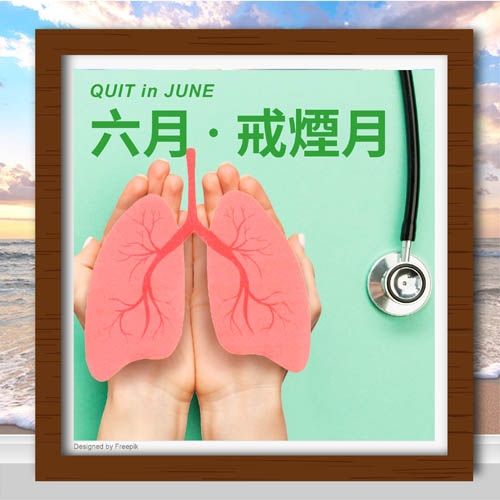
Having quit for a day, your blood pressure and carbon monoxide levels have returned to normal. Keep it up!
Back NextDay 3

If you quit or reduced smoking due to mask wearing for the past 3 years, you must stick with it! If you feel the urge to smoke, try to stop, wait, and take a deep breath. If you still feel it, you can spend 5-10 minutes doing stretching exercises, drink a glass of water, or do other things to distract yourself!
Back NextDay 4
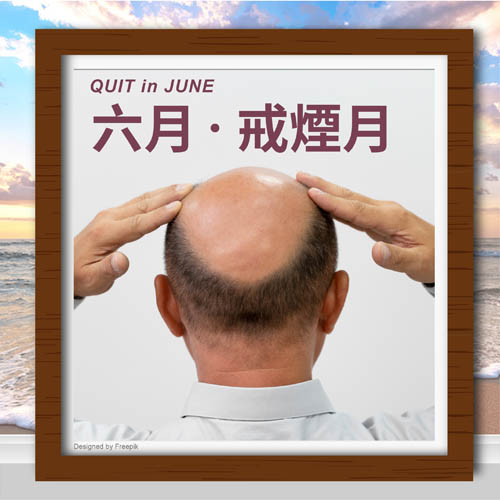
Tobacco smoke contains 7,000 chemicals, of which at least 69 are carcinogens. These harmful chemicals damage blood vessels in your skin and damage the DNA of hair follicles, affecting the hair growth cycle. Studies have shown that male smokers who smoke more than 20 cigarettes a day are at 134% increased risk of hair loss compared to non-smokers.
Not only is smoking harmful to health, it also brings about hair loss issues. Men who smoke should quit as soon as possible!
Back NextDay 5

It is inevitable to experience withdrawal symptoms such as anxiety and low energy levels when quitting smoking. You may mistakenly believe smoking can lessen those symptoms, but the truth is, quitting smoking completely is the only way to break the vicious cycle of addiction. By quitting smoking, your mental health will also improve. Why don’t you give us a call at 1833 183?
Back NextDay 6
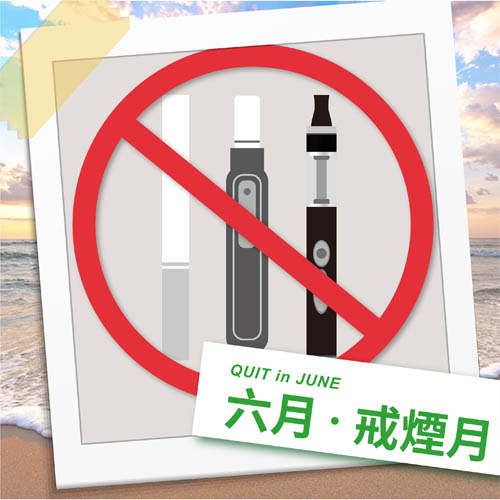
Heated tobacco products and cigarettes contain similar amounts of nicotine, thus are equally addictive. Current data have shown that aerosol generated by heated tobacco products contain at least 80 chemical substances (including carcinogens) that are unique to heated tobacco products or at higher amounts than in cigarettes. So don’t use heated tobacco products while you are quitting smoking, otherwise your efforts would be wasted!
Back NextDay 7

When quitting smoking, try to avoid alcoholic or caffeinated beverages. We recommend drinking water instead. You can add 1 or 2 slices of fresh lemon or orange to the water to freshen up. You can also eat healthy snacks such as apples, bananas, cucumber sticks, cherry tomatoes, roasted nuts, etc, to satisfy your craving.
Back NextDay 8

Smoking reduces blood and oxygen supply to the brain, leading to brain cell damage and death. According to various systematic reviews, smokers are 30-40% more likely to develop dementia and Alzheimer’s Disease compared to non-smokers, and this risk increases with daily amount of smoking! Quit before it is too late!
Back NextDay 9
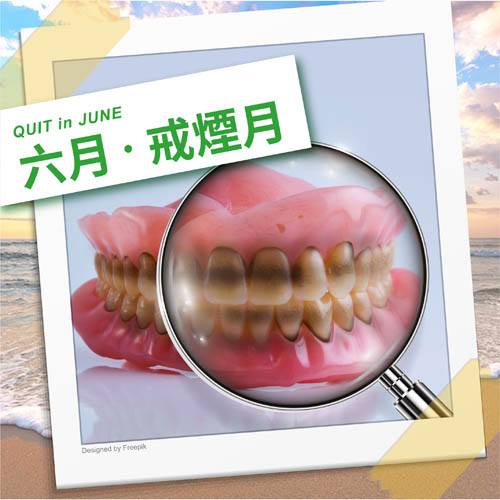
Toxic chemicals in tobacco cause chronic inflammation in oral and bone tissue. They also suppress immune cell function and prevent self-repairing. That’s how smoking increases your risk of periodontitis, causes bad breath, and increases your risk of dental implant failure!
If you want to maintain good oral health and prevent premature tooth loss, stop smoking now!
Back NextDay 10

Studies have shown that heavy daily smokers have fewer taste buds on their tongues, dulling their sense of taste. Quitting smoking can reverse this situation. Usually 2 days after quitting, the sense of taste and smell will start to recover, and it will return to normal levels in about a few months.
Having quit for 10 days, your sense of taste and smell should be heightening! Let’s plan a good meal this weekend~
Back NextDay 11

Smoking not only costs money, it also costs your sperm 😫
Studies have shown that smoking damages sperm DNA and makes sperm shape and motility abnormal. Smokers’ risk of having lower sperm count increases by 29% compared to non-smokers. Smoking affects your fertility! Quit now!
Hang in there! You can ask your family and friends to support you. Stay away from temptations and use other pastimes to distract yourself, such as swimming, listening to music, being outdoors, or catching up with TV dramas. If not, call 1833 183 and we can help~
Back NextDay 12

You can write down your reasons for and difficulties from quitting smoking one by one, combined with the people and situations that hold you back from quitting, how you overcame them, and the experiences and lessons you have learned. You can read it and remind yourself when you’re having a hard time continuing.
The process of quitting smoking is not easy, you can treat yourself to a nice dinner, and encourage yourself to keep going!
Back NextDay 13
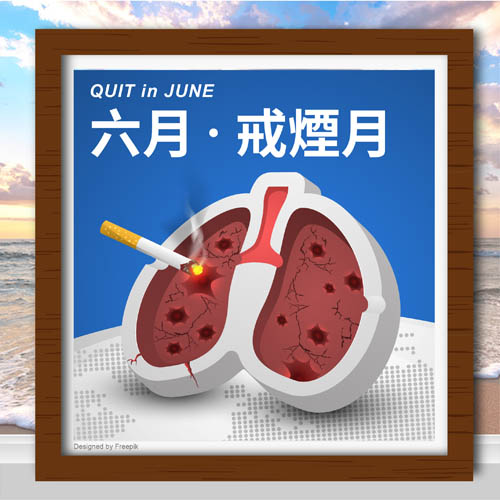
Tobacco smoke destroys respiratory cilia cells, preventing the lungs from effectively clearing mucus secretion and foreign substances such as dust and bacteria. It also weakens your immunity. If infected with COVID-19, you would be at even higher risk of developing severe disease and death! Quit now!
Back NextDay 14

Smoking causes a spike in carbon monoxide levels in the blood, hindering the delivery of oxygen to muscles and tissues, reducing exercise performance and endurance. To improve exercise performance, you must first quit smoking!
Within 2 weeks to 4 months after quitting smoking, the circulatory system and lung function improve. Studies have shown that quitting smoking for just 14 days can improve muscle endurance. Two years after quitting, there is an even more significant improvement in exercise performance.
Want to fully immerse yourself in sports? Quit smoking now!
Back NextDay 15
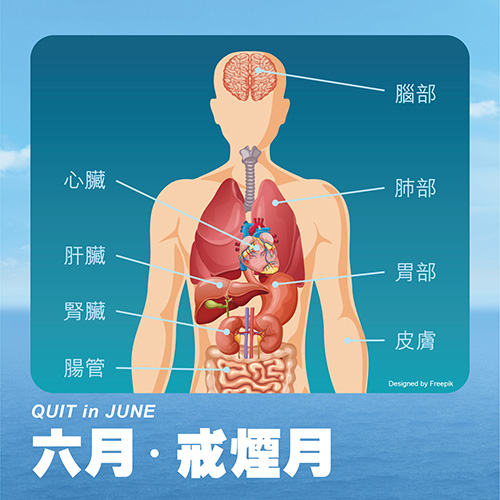
Smoking impairs your fertility by damaging ovarian cells, and lowering fertilisation rate and implantation rate of the fertilised ova into the uterus.
Numerous studies have shown that smokers are 3 times more likely than non-smokers to take more than 1 year to successfully conceive. This risk increases with amount of cigarettes smoked. Moreover, they are at 20-30% increased risk for spontaneous abortions. Women who are trying to conceive should quit immediately!
Back NextDay 16

Smoking causes inflammation in pancreatic cells, and nicotine supresses the normal release of insulin, which in turn causes diabetes.
Meta-analyses have shown that smokers are at 30% increased risk than non-smokers to develop diabetes. If you don’t want this to happen, quit now!
Back NextDay 17

Smoking damages the blood vessels and cells in the corpus cavernosum and affects erectile function. Various international systematic reviews have found that male smokers had a 50% higher rate of erectile dysfunction than non-smokers, and local and mainland studies have found similar results.
The risk of erectile dysfunction is associated with the daily amount of cigarettes smoked. Mainland studies have found that smokers smoking more than 20 cigarettes a day are 65% more likely than non-smokers to have erectile dysfunction.
Smoking affects reproductive health and quality of life. To avoid permanent damage to sexual function, male smokers should quit as soon as possible!
Back NextDay 18

Happy Father’s Day! Give your father the priceless gift of health and encourage him to quit smoking!
Back NextDay 19

Third-hand smoke refers to the nicotine and other harmful substances, such as lead and carcinogens, that remain on the surface of clothing, your body, and household items after smoking. These substances will remain on those surfaces for several days to weeks. They cannot be removed by usual cleaning agents, and will enter the body through breathing and skin contact.
Exposure to secondhand smoke in children increases risk of cancers, middle ear infection, lower respiratory illness, and severe asthma.
You can protect your family from the effects of secondhand and third-hand smoke by quitting smoking. You can also avoid the unpleasant smell left on your body.
For your child’s health, quit now!
Back NextDay 20

The chemicals in tobacco smoke oxidise skin cells, leading to premature ageing. This cannot be reversed by any supplements or skincare! Smoking also increases risk of cervical cancer, premature menopause, osteoporosis, infertility, and other diseases.
Be good to yourself, quit smoking!
Back NextDay 21
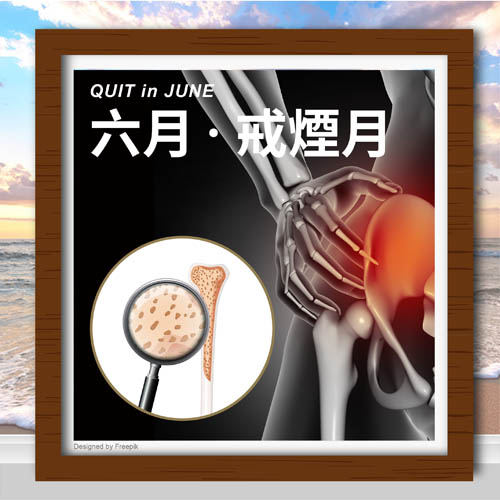
Nicotine and the heavy metal cadmium in tobacco have direct toxic effects on bone cells, lower the absorption of calcium and vitamin D, and increase the risk of osteoporosis. Moreover, smoking leads to early menopause by 1 to 4 years and further accelerates the loss of calcium.
Systematic reviews have found that smokers’ risk of hip fractures is 80% higher than non-smokers. Want to have healthy bones and move freely when you become old? Quit as soon as possible!
Back NextDay 22

Congratulations on being tobacco-free for 3 weeks! Today is Dragon Boat Festival, enjoy swimming and dragon boat racing, and remember to stay away from cigarettes!
Back NextDay 23

Smoking fewer cigarettes doesn’t translate to decreased risk! Meta-analyses pointed out that compared with non-smokers, a cigarette a day increases your risk of stroke by 20% and risk of coronary heart disease by 40%, which is equivalent to that of half a pack!
Simply reducing smoking amounts do not reduce your risk of illnesses and death caused by smoking. Quitting successfully means not smoking at all!
Back NextDay 24

The median salary in Hong Kong is $19,100. If you spend $72 on a pack of cigarettes each day, that adds up to $26,280 per year, which means you are only pocketing 11 months’ salary each year
Back NextDay 25

Smoking impairs the self-repair ability of the retinal cells and causes cumulative structural damages to the eyes with time. Studies have shown that smoking increases the risk of visual impairment and age-related macular degeneration by 2 to 3 times.
Moreover, the heavy metals in tobacco smoke, i.e. lead and cadmium, directly damage the lens, lower the amount of antioxidants and increase your risk of developing cataract by 2 to 3 times.
Want to protect your eyesight? Quit smoking now!
Back NextDay 26
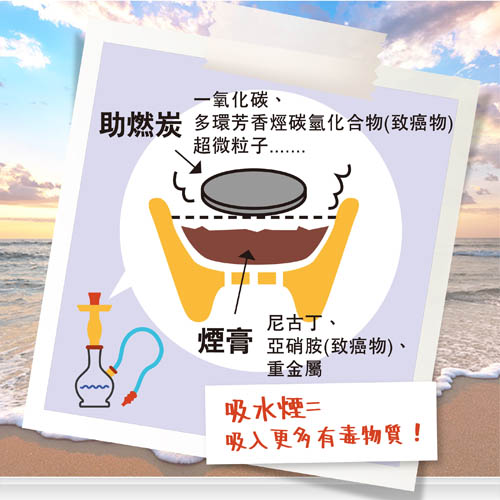
Waterpipe tobacco and charcoal emit large doses of toxicants upon combustion, including carbon monoxide, heavy metals, tar, and carcinogens. The waterpipe smoke being inhaled during a one-hour session of waterpipe smoking can be equivalent to 100 to 200 times that of smoking cigarettes! Because of this, waterpipe smokers inhale more toxicants than cigarette smokers.
It is difficult to completely disinfect the waterpipe apparatus after every use. Research has shown that waterpipe smoking increases the risk of contracting infectious diseases such as herpes, tuberculosis, and hepatitis C. Stay away from waterpipe smoking!
Back NextDay 27

Smokers are at increased risk of dementia, hip fractures, cataracts, and other diseases. Even if you quit smoking after 60 years old, you can still enjoy immediate and long-term benefits.
It’s never too late to quit!
Back NextDay 28

If you have remained tobacco-free for 4 weeks, you have already gotten through the withdrawal symptoms of nicotine. If you encounter environmental cues that might tempt you to smoke in the future, you must remember your persistence and effort today, and say no to smoking.
To avoid temptation, you must reject any offers to smoke and avoid places where people might smoke. Let’s review the many reasons to quit smoking in the past month!
Back NextMake a quit plan
Some people have an easier time quitting than others; some people may try more than a few times in order to quit. While most quitters quit by themselves, there are quit services that can help you along the way and are completely free-of-charge.
When you are planning to quit, you can follow these steps to make a quit plan:
| Mark down your reasons for quitting |
|---|
| Knowing your reasons for quitting can help keep you motivated, especially in difficult moments. |
| Choose a quit method |
| Most quitters quit by themselves, but there are free tools and services which can help you quit easier. |
| Set a quit date |
| The next step is to pick a quit date. Choose a day when you won’t be particularly stressful, avoid deadlines and big projects. This makes you easier to cope with withdrawal symptom. |
| Know and list your triggers |
| knowing what causes your cravings can go a long way in helping you reach your goals. This could also help you develop strategies to keep yourself in control, whether that is to avoid a particular situation or to re-condition yourself through positive reinforcement. |
| Plan positive activities to fight cravings |
| there will be times when you will crave a cigarette more than usual. When you get that urge, change what you are doing and try different positive activities, such as singing or meditation, instead. |
Having willpower and sticking to your quit plan are essential to quitting cold turkey. Your willpower will get stronger over time, you get easier to manage cravings and resist the urge to smoke. Maintaining a balanced diet, and having a positive and optimistic attitude can be helpful on your quit journey.
Give us a call (1833 183) when you need more support or information!




































